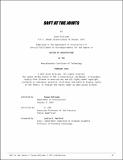Soft at the Joints
Author(s)
Williams, Susan
DownloadThesis PDF (43.62Mb)
Advisor
Jih, J.
Terms of use
Metadata
Show full item recordAbstract
A building can be understood entirely through its joints. It can explain gravitational forces, interlacing moments of material application, and environmental conditions. Yet, this portion of the design is often relegated to the end of the design process, as a finishing touch. The walls, floors, and roof are meticulously considered, while the spaces between are left blank in order to accommodate the imperfections and unsolved complexities that occur when the idealism of design meets the reality of assembly.
In 1851, Gottfried Semper proclaimed, “The beginning of building coincides with the beginning of textiles.” Over the past hundred and fifty years this statement has moved in and out of relevancy as manufacturing, digital tools, design trends and the role of designer and builder has changed. Today, architecture’s relationship with textiles is somewhat estranged. Like the joint, textiles appear at the completion of a project’s development, confined to fulfilling an aesthetic role. Textiles are materials with unique properties which allow for both high levels of strength and flexibility all at the same time. Unlike in architecture, in textiles, the interlacing of fabric is the starting point of both design and construction.
This thesis re-envisions new methods of architectural design through the logics of textiles: by applying principles of aggregation, establishing a dependent relationship between material and structure, and designing through making at a one-to-one scale. As a result, this project acts as a catalyst for playful tectonic systems, eliminating the boundary between where the joint begins and where it ends.
Date issued
2024-02Department
Massachusetts Institute of Technology. Department of ArchitecturePublisher
Massachusetts Institute of Technology